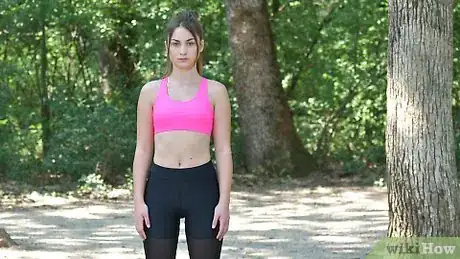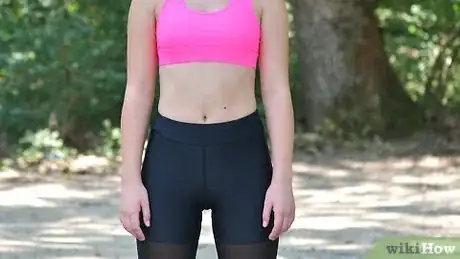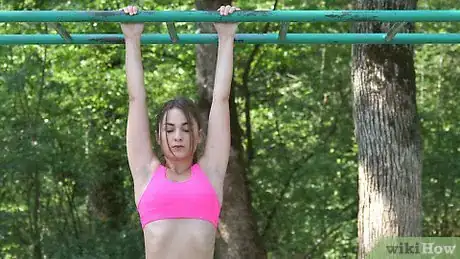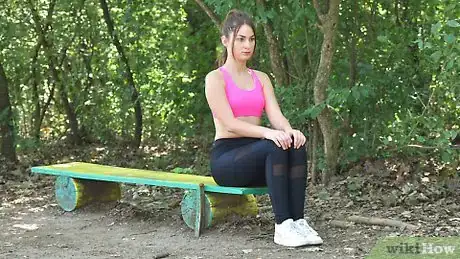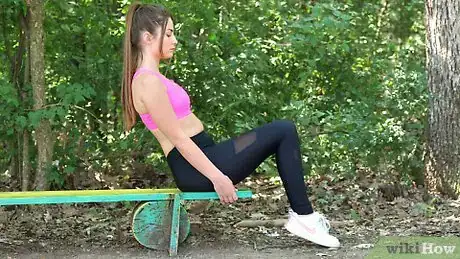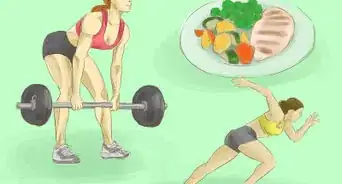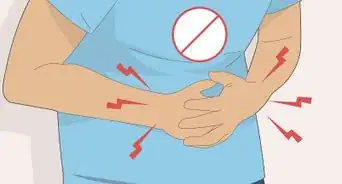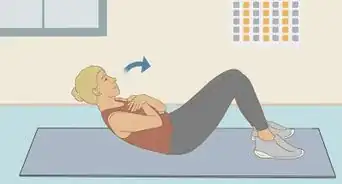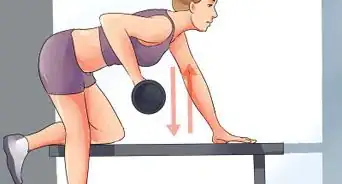This article was co-authored by Alphonso White and by wikiHow staff writer, Megaera Lorenz, PhD. Alphonso White is a Certified Personal Trainer and Fitness Coach at CompleteBody in New York City. With over 20 years of experience in the personal fitness industry, Alphonso specializes in fat loss, toning, and functional training. As an ACE Certified Personal Trainer (ACE-CPT), he creates structured, personal workout plans geared towards short and long-term fitness goals. Alphonso also holds a BS in Nutrition and Exercise Science from Queens College and is a Black Belt in Seido Karate.
There are 9 references cited in this article, which can be found at the bottom of the page.
This article has been viewed 23,541 times.
You might think of knee-ups or knee raises as a leg exercise, but they’re also a great workout for your hips, abs, and core! Sitting or standing knee-ups are simple exercises that you can do at home without any special equipment. For a more challenging exercise that will also work your upper body, try doing hanging knee-ups on a pull-up bar or gymnastics rings.
Steps
Standing Knee Ups
-
1Stand upright with your knees hip-width apart. Get into a comfortable standing position with your back straight and tall and your shoulders squared. Plant your feet so they’re slightly apart, and keep your knees lined up under your hips.[1]
- If you have trouble balancing, you can do this exercise while standing next to a chair or counter and rest your hand on it for support.[2]
-
2Brace your core muscles. Gently tense the muscles in your abdomen, sides, and lower back. Engaging these muscles will help you build strength in your core.[3]
- To find your core muscles, imagine creating a firm band or belt of muscle around your lower body. You can also try pulling your belly button in towards your spine.
- This exercise also helps strengthen your hips.[4]
Advertisement -
3
-
4Hold for 1-2 seconds before returning to the start position. Pause for a second or 2 with your knee raised. Then, slowly and smoothly put your foot back on the floor while breathing out.[7]
-
5Switch to the other leg and repeat. After raising and lowering one knee, repeat the same process on the other side. Or, you can do several raises on one side, then switch to the other.[8]
- Do 1-2 sets of 10-15 reps, either alternating knees or doing one side and then the other as separate sets.
- To make the exercise more challenging, you can try doing more reps or adding small weights to your ankles.
Hanging Knee Ups
-
1Grab a pull-up bar or gymnastics rings with an overhand grip. Hanging knee ups are also known as hanging knee raises. Stand under a bar or a set of gymnastics rings with your back straight and tall. Reach straight up with your palms facing forwards and grab the bar or rings from behind.[9]
- Your hands should be about shoulder-width apart.
- In your starting position, your arms should be completely straight, and your feet should be slightly off the floor.
- This exercise is similar to a vertical knee raise, or “Captain’s Chair.” To do a vertical knee raise, instead of reaching up to grab a bar, you’d start by resting your forearms on a pair of parallel bars, as if they were the armrests on a chair.
-
2Pull your knees up toward your chest. Brace your core and tighten your abs. Try to use those muscles to lift your legs.[10] Raise your knees up as far as you can, and try to touch your chest with the tops of your thighs.[11]
- Keep your body as still as you can, and try to keep the motion of your legs slow and smooth. Don’t let your body swing from side to side or twist around.
- If you have trouble lifting your legs high enough to touch your chest, aim to raise your knees until your thighs are parallel to the floor.[12]
-
3Lower your legs in a slow, controlled motion. Once you reach the top of the knee-up, slowly and carefully return to your starting position. Don’t let your legs suddenly drop, and try not to do any fast or jerky movements.[13]
- Slow, controlled movements will make the exercise more effective.
-
4Aim for 3 sets of 10 reps. This is an exercise that takes a lot of strength, so don’t worry if you can’t do a ton of reps right away. 3 sets of 10 reps is a good general goal to aim for when you’re doing any strength-building exercise.[14] If you can’t manage that, start with a smaller number, like 2 sets of 5 reps.
- This is a great exercise for your lower abs, but you’ll also build strength in your hips, arms, shoulders, and upper back.[15]
Sitting Knee Ups
-
1Sit on the edge of a chair or bench. Find a chair or workout bench and sit tall, with your back straight. Put your feet flat on the floor in front of you.[16]
- If you’re sitting on a chair with a back, sit far enough forward so that you can tilt your body back in the chair.
-
2Lean back so you’re partially reclining and grab the sides of the chair. Slowly tilt back on your buttocks until your body is leaning at a 45° angle. Hold onto the sides of the chair to keep you from falling backwards.[17]
- If you’re on a bench, you can also stabilize yourself by reaching back and resting your hands on the bench behind you.
-
3Lift both knees toward your chest. Brace your abdominal muscles and slowly pull your knees up toward your chest. Keep your back straight and only move your lower body (legs and hips).[18]
- Keep your core engaged as you raise your legs. Don’t allow your upper body to rock back as your legs come up.
-
4Lower your legs slowly back to the starting position. Once you’ve pulled your legs up as far as they can comfortably go, lower them back toward the floor in a slow, controlled motion. Ideally, they shouldn’t quite touch the ground before you start lifting them back up again.
- Your abs will get a better workout if you don’t let your feet touch the floor between lifts. However, it’s okay to touch the floor if you find it too difficult to keep your feet up.
-
5Repeat this exercise 10-15 times. Keep raising and lowering your knees several more times—aim for about 10-15. If you like, you can rest for a few minutes, then do another set. With practice, you will eventually be able to complete more repetitions.[19]
- This exercise is great for toning your abs, especially if you keep them engaged and tight throughout the whole workout. It will also help strengthen your lower back, hips, and glutes.
Expert Q&A
-
QuestionHow do you perform knee ups?
 Alphonso WhiteAlphonso White is a Certified Personal Trainer and Fitness Coach at CompleteBody in New York City. With over 20 years of experience in the personal fitness industry, Alphonso specializes in fat loss, toning, and functional training. As an ACE Certified Personal Trainer (ACE-CPT), he creates structured, personal workout plans geared towards short and long-term fitness goals. Alphonso also holds a BS in Nutrition and Exercise Science from Queens College and is a Black Belt in Seido Karate.
Alphonso WhiteAlphonso White is a Certified Personal Trainer and Fitness Coach at CompleteBody in New York City. With over 20 years of experience in the personal fitness industry, Alphonso specializes in fat loss, toning, and functional training. As an ACE Certified Personal Trainer (ACE-CPT), he creates structured, personal workout plans geared towards short and long-term fitness goals. Alphonso also holds a BS in Nutrition and Exercise Science from Queens College and is a Black Belt in Seido Karate.
Certified Personal Trainer, CompleteBody NYC Standing tall, quickly lift one leg with a bent knee until your knee is waist height. Lower your leg quickly and repeat with the other leg, then continue alternating.
Standing tall, quickly lift one leg with a bent knee until your knee is waist height. Lower your leg quickly and repeat with the other leg, then continue alternating. -
QuestionWhat are some variations for knee ups?
 Alphonso WhiteAlphonso White is a Certified Personal Trainer and Fitness Coach at CompleteBody in New York City. With over 20 years of experience in the personal fitness industry, Alphonso specializes in fat loss, toning, and functional training. As an ACE Certified Personal Trainer (ACE-CPT), he creates structured, personal workout plans geared towards short and long-term fitness goals. Alphonso also holds a BS in Nutrition and Exercise Science from Queens College and is a Black Belt in Seido Karate.
Alphonso WhiteAlphonso White is a Certified Personal Trainer and Fitness Coach at CompleteBody in New York City. With over 20 years of experience in the personal fitness industry, Alphonso specializes in fat loss, toning, and functional training. As an ACE Certified Personal Trainer (ACE-CPT), he creates structured, personal workout plans geared towards short and long-term fitness goals. Alphonso also holds a BS in Nutrition and Exercise Science from Queens College and is a Black Belt in Seido Karate.
Certified Personal Trainer, CompleteBody NYC To make the exercise more challenging, alternate your knees up and down very quickly, almost like you're sprinting in place. You can also perform the exercise with an exercise loop or band around your feet, or you could perform the exercise while you're hanging.
To make the exercise more challenging, alternate your knees up and down very quickly, almost like you're sprinting in place. You can also perform the exercise with an exercise loop or band around your feet, or you could perform the exercise while you're hanging.
Warnings
- If you have any injuries to your knees or back, talk to your doctor before trying these exercises. It’s a good idea to get medical advice before starting any new exercise program, especially if you have any serious health concerns.⧼thumbs_response⧽
References
- ↑ https://www.msn.com/en-us/health/exercise/strength/knee-raises/ss-BBtOf0P
- ↑ http://move.bangor.ac.uk/home-exercise/lower-body/knee-raises.php.en
- ↑ https://www.msn.com/en-us/health/exercise/strength/knee-raises/ss-BBtOf0P
- ↑ http://move.bangor.ac.uk/home-exercise/lower-body/knee-raises.php.en
- ↑ https://www.msn.com/en-us/health/exercise/strength/knee-raises/ss-BBtOf0P
- ↑ http://move.bangor.ac.uk/home-exercise/lower-body/knee-raises.php.en
- ↑ http://move.bangor.ac.uk/home-exercise/lower-body/knee-raises.php.en
- ↑ http://move.bangor.ac.uk/home-exercise/lower-body/knee-raises.php.en
- ↑ https://www.msn.com/en-us/health/exercise/strength/hanging-knee-raise/ss-BBtOfg5
- ↑ Alphonso White. Certified Personal Trainer, CompleteBody NYC. Expert Interview. 24 February 2021.
- ↑ https://www.msn.com/en-us/health/exercise/strength/hanging-knee-raise/ss-BBtOfg5
- ↑ https://www.coachmag.co.uk/abs-exercises/6696/how-to-do-a-hanging-knee-raise
- ↑ https://www.coachmag.co.uk/abs-exercises/6696/how-to-do-a-hanging-knee-raise
- ↑ https://www.nerdfitness.com/blog/the-correct-number-of-reps-per-set-in-the-gym/
- ↑ https://www.msn.com/en-us/health/exercise/strength/hanging-knee-raise/ss-BBtOfg5
- ↑ https://heartfitforlife.org/cardia/wp-content/uploads/2015/05/Core-Training-Part-2-.pdf
- ↑ https://heartfitforlife.org/cardia/wp-content/uploads/2015/05/Core-Training-Part-2-.pdf
- ↑ https://heartfitforlife.org/cardia/wp-content/uploads/2015/05/Core-Training-Part-2-.pdf
- ↑ https://heartfitforlife.org/cardia/wp-content/uploads/2015/05/Core-Training-Part-2-.pdf
- ↑ https://www.acefitness.org/getfit/studies/bestworstabexercises.pdf
- ↑ https://www.spine-health.com/glossary/flexion
